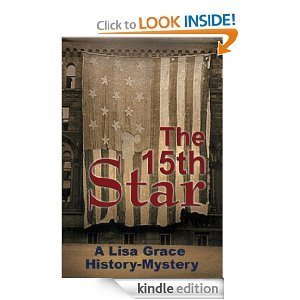R.M. Strong's Blog, page 2
January 11, 2014
19 by Aaron Patterson
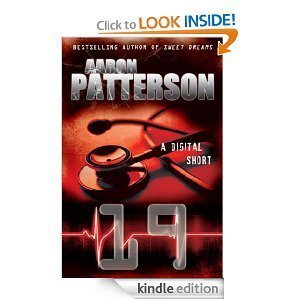 The short story “19″ is a quick read by Aaron Patterson. It took me less than two hours to finish the story.
The short story “19″ is a quick read by Aaron Patterson. It took me less than two hours to finish the story.
The story opens with Henry getting a letter out of the blue from Mandy, his ex-fiancé–about 60-years ex. This is the only time we see Henry. The rest of the story is in the form of a manuscript sent to a writer ex-boyfriend. Henry never returns, we never hear about what caused the breakup of their relationship, or even, really, why he is there.
The “manuscript”–the rest of the short story–is written choppily. We see little vignettes of the main character’s past before jumping ahead nearly 50 years to where the bulk of the story resides.
I really didn’t enjoy Mandy much. She seemed whiny, paranoid and a little OCD there at the end. The “special power” the women in her family seem to have–knowing when someone is going to die–only seems to work once. There is never any mention of the smell of roses (a better title for the story) coming more than once, but it frightens her nearly to death when it happens (granted, her husband is in the hospital at the time, but still).
There were a few times when Mandy breaks off from her “manuscript” and speaks directly to Henry (without mentioning his name). These few instances are rather jarring. Once, she also uses the word “puke,” which is just as jarring. Yes, the word has been used in English since Shakespeare’s time, but it didn’t seem to fit the character.
The formatting of the ebook leaves a great deal to be desired. There are no “page” breaks, each section starts right after the previous one. Instead of starting at the preface (a quote from Romeo and Juliet, which is not attributed properly), the file opens at the copyright page. There is no demarcation between parts other than a quick reference to the side and the entire file is in italic text.
If you’re looking for a quick read this one is enjoyable enough. If you’re looking for a thriller, or something that will keep you on the edge of your seat, you might want to look somewhere else.


January 4, 2014
Paleo Foods for Busy People, The 30-day Paleo Diet Challenge
Diet is a 4-letter word. Especially to author Emma Powell. Her goal in writing the cookbook was to “redefine the word ‘diet,’ returning to  a more traditional definition and use of the word.”
a more traditional definition and use of the word.”
Diets are not simply a method to shed unwanted weight. They are not about restriction. The word Diet, to Ms. Powell, is all about lifestyle and the type of food.
The Paleolithic diet, she asserts is the one that humans are most attuned to—one of whole, unprocessed foods. The list of unrestricted foods and those allowed in moderation (including caffeinated beverages) is longer than the foods excluded from the Paleo diet.
The book comes complete with a 30-day meal plan—recipes for breakfast, lunch, and dinner for two or more including pancakes (using coconut and almond flour), pulled pork, stir fry, salads and smoothies galore.
I have not yet used an e-cookbook, and was interested to see how it worked. It’s going to be more difficult to flip through the pages, but as the recipes are part of a meal plan rather than a collection of recipes, I am not anticipating a problem.
The pictures included in the book, which are of high-quality and professionally-produced are enticing in black and white on the Kindle and simply mouth-watering in color on the Kindle app on my tablet.
Don’t get me wrong, I love me my pasta, rice, and bread, but the 30 days of recipes included in the book sound good enough to at least give the Paleo diet a try.
Now, I just need to go out and get a good blender.


December 26, 2013
All Things Hidden
When Gwen Hiller man and her country-physician father were called to Anchorage, Alaska in early 1935, she had no idea how her life was going to change, just that it would. Gwen hated change. Change always came along with loss and heartache—most notably, the loss of Edith and Sophia, her mother and sister.
man and her country-physician father were called to Anchorage, Alaska in early 1935, she had no idea how her life was going to change, just that it would. Gwen hated change. Change always came along with loss and heartache—most notably, the loss of Edith and Sophia, her mother and sister.
In Chicago, Dr. Jeremiah Vaughan, has his life all in order. He is on the cutting edge of medicine, he is engaged to one Miss Sophia Hillerman, and all seems to be going well… until one fateful night. One fall down a flight of stairs sets in motion the disintegration of his life. Just as all hope seems lost, he gets a letter from his former mentor—the man who, he had always been told, abandoned his fiancée—to join him in Alaska for some wonderful adventures in frontier medicine. Without any other options, Jeremiah travels to the last frontier… carrying with him a devastating secret.
All Things Hidden (ebook format) was given to me by the publisher in return for an honest review.
Historical fiction is always tricky, but the authors did a good job. The historical elements of FDR’s New Deal project to move 200 families to Alaska are in their proper context. The authors incorporate historical and fictional characters well and properly. Both fictional and true elements are separated into their respective categories in both a forward and an afterward.
The story itself is quaint and somewhat believable. The book is written in third person omniscient, with three main points of view (hero, heroine, and villain), with a few minor characters’ POVs thrown in. Each new POV and jump in time is clearly marked, making it easy to understand whose head the reader is in. The villain’s POV is the most unique, with a different voice and vocabulary. The others, though, are harder to differentiate. The grandmother character is slightly unbelievable, in my opinion, but not horribly so. I was able to read the book in a few large chunks and in about six hours total.
With the exception of the villain, all main characters are Christian and the book is written from a blatantly, unapologetic Christian perspective.
The story, however, is predictable. For me, there were no surprise twists. (Enough that I mused that the book was poorly titled.) It was a plain-and-simple romance. I’m not particularly a fan of chick lit, but the historical fiction made the story more interesting than a simple fluffy romance.
The pre-release review copy I was given was the first I received from Bethany House Publishing. It was absolutely rife with conversion errors (errors that would not be present in a print copy, but come from creating the ebook from another format—probably PDF). This may not be the issue in the published ebook (release date, January 7, 2014), but if they have not fixed the issues, the book takes quite a lot of effort to get used to. Once my brain knew what was missing and was able to insert the missing characters (most noticeable, the double F—such as in off, office, Griffin, different, etc.), the reading was only slightly compromised.
All in all, if you like romance, All Things Hidden would be an enjoyable read. The writing, plot and historical aspect of it was enough to keep me—who is, as I said, not a fan of romance—reading.


All Things Hidden by Tracie Peterson and Kimberly Woodhouse
When Gwen Hiller man and her country-physician father were called to Anchorage, Alaska in early 1935, she had no idea how her life was going to change, just that it would. Gwen hated change. Change always came along with loss and heartache—most notably, the loss of Edith and Sophia, her mother and sister.
man and her country-physician father were called to Anchorage, Alaska in early 1935, she had no idea how her life was going to change, just that it would. Gwen hated change. Change always came along with loss and heartache—most notably, the loss of Edith and Sophia, her mother and sister.
In Chicago, Dr. Jeremiah Vaughan, has his life all in order. He is on the cutting edge of medicine, he is engaged to one Miss Sophia Hillerman, and all seems to be going well… until one fateful night. One fall down a flight of stairs sets in motion the disintegration of his life. Just as all hope seems lost, he gets a letter from his former mentor—the man who, he had always been told, abandoned his fiancée—to join him in Alaska for some wonderful adventures in frontier medicine. Without any other options, Jeremiah travels to the last frontier… carrying with him a devastating secret.
All Things Hidden (ebook format) was given to me by the publisher in return for an honest review.
Historical fiction is always tricky, but the authors did a good job. The historical elements of FDR’s New Deal project to move 200 families to Alaska are in their proper context. The authors incorporate historical and fictional characters well and properly. Both fictional and true elements are separated into their respective categories in both a forward and an afterward.
The story itself is quaint and somewhat believable. The book is written in third person omniscient, with three main points of view (hero, heroine, and villain), with a few minor characters’ POVs thrown in. Each new POV and jump in time is clearly marked, making it easy to understand whose head the reader is in. The villain’s POV is the most unique, with a different voice and vocabulary. The others, though, are harder to differentiate. The grandmother character is slightly unbelievable, in my opinion, but not horribly so. I was able to read the book in a few large chunks and in about six hours total.
With the exception of the villain, all main characters are Christian and the book is written from a blatantly, unapologetic Christian perspective.
The story, however, is predictable. For me, there were no surprise twists. (Enough that I mused that the book was poorly titled.) It was a plain-and-simple romance. I’m not particularly a fan of chick lit, but the historical fiction made the story more interesting than a simple fluffy romance.
The pre-release review copy I was given was the first I received from Bethany House Publishing. It was absolutely rife with conversion errors (errors that would not be present in a print copy, but come from creating the ebook from another format—probably PDF). This may not be the issue in the published ebook (release date, January 7, 2014), but if they have not fixed the issues, the book takes quite a lot of effort to get used to. Once my brain knew what was missing and was able to insert the missing characters (most noticeable, the double F—such as in off, office, Griffin, different, etc.), the reading was only slightly compromised.
All in all, if you like romance, All Things Hidden would be an enjoyable read. The writing, plot and historical aspect of it was enough to keep me—who is, as I said, not a fan of romance—reading.


November 30, 2013
Return to Me by Lynn Austin
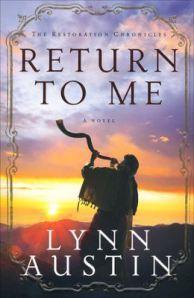 Writing historical fiction can be tricky. Because the book contains actual historical events, authors assume the risk that some readers will take every word written to be true. No matter how much research is done, an element of fiction can seep its way into a reader’s mind as fact (for example: pirates did not actually make prisoners walk the plank, nor did they bury treasure and mark their maps with an X). With regular historical fiction this has little lasting effect, when writing biblical historical fiction, the weightiness of the task should spur the author on to extensive research—not just on the biblical front to get the narrative, but also into the culture of the time period.
Writing historical fiction can be tricky. Because the book contains actual historical events, authors assume the risk that some readers will take every word written to be true. No matter how much research is done, an element of fiction can seep its way into a reader’s mind as fact (for example: pirates did not actually make prisoners walk the plank, nor did they bury treasure and mark their maps with an X). With regular historical fiction this has little lasting effect, when writing biblical historical fiction, the weightiness of the task should spur the author on to extensive research—not just on the biblical front to get the narrative, but also into the culture of the time period.
I received Return to Me by Lynn Austin from the publisher specifically for review. The story begins in the ancient city of Babylon. The Jewish people have been conquered and in exile for close to seventy years. When the Persians take over the city, King Cyrus allowed—even encouraged the Jews to return and rebuild God’s temple in Jerusalem. The book follows the lives of one of the families returning, Iddo, his wife Dinah, his grandson Zechariah, and “Zaki’s” friend Yael. Spanning more than twenty years, Return to Me takes us through the first few decades back in Jerusalem.
Return to Me is an enjoyable-enough story. It follows the biblical timeline well enough and gives good insight into the tensions and temptations that the returning Jews faced, especially in regard to their Samaritan neighbors. The characters are believable and likable. Each chapter is told from one of the four main characters’ points of view. It is sometimes difficult to remember who is who—the children both call their parents “Abba” and “Mama”—but it does not usually detract from the story.
My main issue with the book, though, is while the author did her scriptural research and consulted some commentaries, according to the acknowledgements at the end of the book, there seemed to be very little research done on Jewish culture of the time. All of the Jews in the story seem to be modern Jews going about modern lives.
The author has Zechariah going to yeshiva in Babylon. While there is no historical evidence of the Jewish religious schools in Babylon, it is not entirely out of the realm of possibility that the teachers and other elders may have set up some semblance of the religious school during that time in exile. However, there is not a yeshiva mentioned in history for at least 400 years after the exiles returned to Jerusalem. Still, that can be mostly overlooked. Unfortunately, that is not where the historical discrepancies stop.
Zechariah spends much of his time in the yeshiva studying for his bar mitzvah—the day when he would read the Torah in the house of assembly and officially become a man in the eyes of the community. He reads the Torah, and then they return to their communal family home to a very large banquet and party for friends and neighbors—which is how bar mitzvahs are celebrated in today’s culture. During their times of study, the men of the community also wear a kippah (yarmulke or a skull cap). These are both horribly period inappropriate—by nearly 1000 years, perhaps longer.
Instead of looking for husbands for daughters when they come of age in the Jewish culture (at age 12, or when puberty hits), teenage—and older—daughters are encouraged to wait until they are older to marry. For example, Yael comes of age during the migration from Babylon to Jerusalem, but her father waits more than ten years to marry her off. The mother of a 16-year-old girl holds off a marriage because she’s “much too young,” when, in fact, for the time and culture, she’s bordering on “old maid” status.
Austin may have simply been trying to equate what the modern reader knows about bar mitzvahs and current Jewish culture to her ancient characters. However, if that is the case, then it should have been stated at the end of the book in the acknowledgements, the author’s note, or a note from the editor. I was able to find out the above-mentioned three things were not period appropriate in less than five minutes on the Internet. As it stands, it gives the feel that the author may have decided that reading the Bible and commentaries on the text was the only research that needed to be done to write an accurate biblical historical fiction which, in my opinion, is lazy storytelling.
Austin, for reasons unmentioned, also decides to exclude Nehemiah and his rebuilding of the wall of Jerusalem in her narrative. While it is not crucial to her story, and I understand why she might have chosen to leave it out for the purposes of space and word count, the security of Jerusalem—even after the wall was supposed to have been built—is mentioned many times, making me wonder why such a miracle was left out. Large spaces of time—years, even a decade at one point—are skipped over in the book, during which the wall could have been built and Nehemiah return to his job as cup bearer to King Artaxerxes. This, however, would not leave the city completely undefended as is implied in the last few chapters.
For avid readers of and researchers into biblical culture and the biblical narrative’s cultural history, I would recommend against this book. The errors—while not earth-shattering—are mentioned continually and will leave the reader with the feeling that the author did not do her due diligence in her research for the book. For those who are not distracted by historically-inaccurate historical fiction, the book is well-written and the story well-told.


September 23, 2013
Perfect Forgiveness by Shaina Cilimberg
 Perfect Forgiveness is the second in the Deep River High series by Shaina Cilimberg (the first being Crowded, reviewed below). The main characters in Crowded (Lydia, Emily, and Josh) are now secondary characters, but still present.
Perfect Forgiveness is the second in the Deep River High series by Shaina Cilimberg (the first being Crowded, reviewed below). The main characters in Crowded (Lydia, Emily, and Josh) are now secondary characters, but still present.
Without any unneeded introduction, the story thrusts us into the next year of Deep River High, with protagonist Kirk Williams being shoved into a bank of lockers. The bullying that was present in the first book is only amplified in the second. Because of the bullying he suffers—from classmates as well as the two boys who call themselves his best friends—Kirk goes along with his friends’ plan to “shoot down” the school to cleanse it of bullies.
On November 1, over 20 people lost their lives at Deep River High. Kirk is the only one of the three shooters left standing at the end of the rampage and is the only one left to face the consequences (the other two die by another shooter’s hands). The remaining 65% of the book is dealing with the aftermath of the shooting and how the kids (and youth pastor) at the Eastside Church of Christ and the school—and most especially Kirk himself—deals with the feelings of remorse, guilt, rage, confusion and the rest of the emotions that go along with such a traumatic experience.
The author, whom I know through Facebook, lost a friend due to bullycide (suicide caused by excessive bullying). The Anti-Bullying message is an extremely important one to this author—for good and noble reasons—and that is to be respected. She also does a good job of allowing her characters from the first book to grow along with their chronological age. The head-hopping, which some people dislike, is done well, and there are usually chapter breaks or other indications in the formatting that a new point of view is being used.
The book, however, is full of small errors, enough to lower its rating. There are missing (or extra) punctuation marks or poor grammar choices throughout the book—one every other screen or so on my Kindle. There are also formatting issues (some of which are the fault of the ebook conversion software, but some are not) which can make the text sometimes hard to understand or follow.
Most glaring, though, are the continuity issues. The shooting seems to last for at least an hour—with kids wandering the halls before school or practically stepping over dead and dying girls to get to the cafeteria to laugh and mingle with their friends, oblivious to what is going on. Kirk shoots nearly 20 people with a sawed-off shotgun, never having to reload. There is also never a clear indication of how many people are shot by which perpetrator. There is also very little indication of exactly how many people are wounded (only a list of the dead is given), and in some places, the number of people Kirk shot (killed or wounded) changes from one chapter to the next. Finally, there are still some liberties taken with the legal system, but far fewer than in previous editions.
The book could use a good, thorough going-over by a professional editor. As it stands, though, while the story is a good one and should be told, the book is poorly executed.


September 7, 2013
The 15th Star by Lisa Grace
I am a fan of history and historical fictions. I also like mysteries. I was intrigued at the synapsis of this “history-mystery.” When done well, the combination can be amazing, it can keep you on the edge of your seat and keep you riveted to the page or the screen.
The story of The 15th Star is a compelling one. Borrowing her plot lines from history, Ms. Grace brings together truths and fiction to weave together a story spanning two centuries. When Grace Wisher, a slave girl on a cotton plantation in the South, is told that she has to allow one of the white men on the plantation to impregnate her, runs away. She, unlike most slaves, is able to make a clean break and runs to Baltimore, where she soon finds herself the indentured worker of Mary Pickersgill, a flag and banner maker. When delivering the Star-Spangled Banner made famous in Francis Scott Key’s poem written during the War of 1812, Grace befriends Mrs. Louisa Armistead, who promises to help Grace learn to read and write. Their correspondence is later saved.
It is this correspondence that is the glue that holds the past to the present. In the present day, Keiko—a grad student working at the Smithsonian—comes across an intriguing letter in papers of Mrs. Armistead’s donated to the museum. Intrigued by the mention of a star from the Armistead Flag, she goes on a whirlwind adventure with a new friend. Who knows what the next 24 hours will hold?
The book head-jumps quite often, though that type of storytelling does not bother me as much as it does others. Most of the jumps are in between chapter breaks, though there are a few rather abrupt ones when the present-day male and female lead characters are together.
The plot’s bones are strong and the flesh of the story is strong in most places. There are, as with any book, some places where you have to roll your eyes. There are some issues with the present-day antagonist’s motivation. There are a few connections between different characters that are somewhat unbelievable, and the chapter titles are not consistent (some are dates, some are locations, some are phrases). It is also an interesting editorial choice to use the term “Indian” where most present-day institutions use “Native American,” or “First Peoples.”
All in all, though, it was a pleasant read, especially after the latest updates which resolved editorial and formatting issues present in the first edition.


September 1, 2013
Three Children’s Books
This time, I am reviewing three children’s’ books my son and I read while on a trip across town on public transportation. I have also asked my son, who is 6 and reads at a third grade level, to give his opinions of the books, answering three simple questions (What is the book about? Did you like it? Why or why not?).
Olivia’s Pod: An Orca’s Tale by Kurt Medinger:
Son: It is about a Orca—a fish thing. I loved the book because it’s cute!
Mom: Olivia’s Pod is a book I received for free in exchange for a review. The book follows the life of a killer whale named Olivia who lives with her family group and travels from Alaska to Washington in search of food. The author used images of whales from the National Oceanic and Atmospheric Administration to help illustrate the story. The book is a good read for a 5 – 8 year old, the text is simple enough—and the larger or more scientific words are explained in terms a young school-aged child can understand. The book is more informative than entertaining, and the “tale” is more “a day in the life of,” however, Olivia was a good, quick read and even on my black-and-white Kindle screen the images were crisp and clear. I would definitely recommend it to someone whose young child wanted to learn more about killer whales.
Monsters I Know by Peter 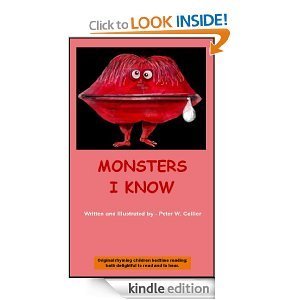 W. Collier:
W. Collier:
Son: The book is about monsters. I loved the book because I like the monsters. My favorite monster was the spaghetti one!
Mom: I didn’t like this one as much as my 6-year-old. It is not formatted well for Kindle, though I think that those issues may resolve themselves in print. Many of the words are too long for a first grader and I did have to stop and explain what some words meant to my son. I found some of the rhymes ill-contrived (“lint” and “footprints”, “insist” and “this”, “unexplained” and “again”, etc., don’t rhyme). There is no set cadence to any of the vignettes and very little punctuation (many lines end in semicolons) to help the rhymes flow. My son—the target audience—loved the book and the illustrations (which were a bit childish), though, and we will keep the book on the Kindle since he can read it on his own. I definitely will not be reading the book to him again.
The Kitten That Roared: A Kitten Called Kitters by Bob Guelfi. 
Son: The book is about a kitten called Kitters who wanted to be a tiger. I loved the book because the pictures were cute.
Mom: This one was better than Monsters I Know, and a good way to round out the bus trip. Kitters is a small kitten who wanted to be a tiger, all well and good. The pictures, as my son said, are very well done, and the book is formatted as images on the Kindle so everything looks the way it would in print (minus, on mine, the color). The text is a little hard to read when it is over a dark background, but the words have a glow effect around them and, while difficult, it is not unreadable. Kitters tells a story of courage. The word choice is excellent for the target age group. The only thing I would have changed is the moral of the story. It is not a bad moral, but it just seemed as if the author put it in there just to have a moral. It fits well with the story, but not necessarily the storytelling. All in all, though, a good book and one we will probably be reading again.


August 24, 2013
Dragonwitch by Anne Elisabeth Stengl
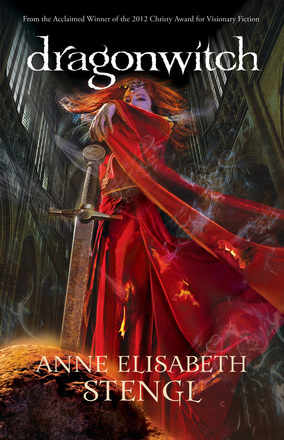 Dragonwitch is the first of Anne Elisabeth Stengl’s books that I have read, and is fifth in the Tales of Goldstone Wood series. I was given this free review copy by the publisher (Bethany House Publications), but after reading Dragonwitch, I definitely will be going back to read the first four in the series.
Dragonwitch is the first of Anne Elisabeth Stengl’s books that I have read, and is fifth in the Tales of Goldstone Wood series. I was given this free review copy by the publisher (Bethany House Publications), but after reading Dragonwitch, I definitely will be going back to read the first four in the series.
Truth be told, I would not have expected this book to be published by Bethany House Publishing. I grew up with Bethany House printing the fiction my grandmothers loved to read—Old West historical romances, mainly, and a lot of Janette Oake and Judith Pella. The book and its contents surprised me—a good surprise, but a surprise nonetheless. Despite none of the overt spiritual references and strong Christian characters I had come to associate with Bethany House, I still found myself marvelling at some of the spiritual truths hidden in plain sight.
I am a fan of the fantasy of Lewis and Tolkien, but little contemporary fantasy. Stengl, however, weaves such an integrated world it was hard not to get drawn in. Some of it, of course, comes from this book being late in the series and the author having had time to interact with her world properly. Most of it, however, comes from the author’s ability to paint pictures with words to create a world where you can feel the moss of the Wood under your feet, you can watch the Path spread out before you, and you can smell the stink of fear hovering over the goblin’s human captives.
The story takes place in four separate, distinct realms. It begins in the cold reaches of the North Country, where young Lord Alistair is reluctantly learning to read, and the castle Chronicler is reluctantly teaching him. He is being groomed for an earlship and, everyone hopes, the throne. He never feels comfortable with his mother’s scheming, or with Leta, the girl that his uncle and mother have chosen for him to wed. When his uncle, the earl dies, a surprise deathbed confession changes everything Alistair knew.
As I mentioned above, the religious themes are subtle and sometimes hidden. In one such passage, the Chronicler and Leta—who is clandestinely learning to read and write—are having a discussion about the faerie tales which the Chronicler simply calls, “Silly superstition.”
“Maybe,” she replied. “Maybe not. But I believe it.”
“What you believe cannot affect the truth of the matter.”
“Cannot the same be said for unbelief?”
“A good point, m’lady, and a fair one,” said he.
This particular theme—that whether or not we believe something to be true has no bearing on its actual fact—is repeated throughout the book if one cares to look.
In the printed book I received, I did notice a few layout issues, but nothing to detract from the story.
Any time spent reading the work of a true wordsmith is never time wasted. I will definitely be reading more of Stengl’s works in the future.


August 17, 2013
A Shadow On The Land by Krystine Kercher
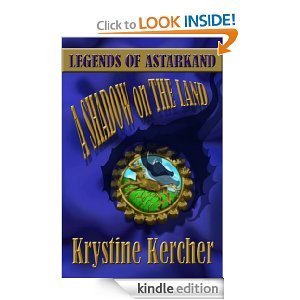 A Shadow on the Land was my first venture into Astarkand and won’t be my last.
A Shadow on the Land was my first venture into Astarkand and won’t be my last.
The story follows the adventures of Bjorn Horsa, a self-exiled prince in the court of King Olaf of Astarkand, and his men. He was the child of prophecy, the one destined to release the land from the shadow of a vengeful, bloodthirsty elf-god. If only King Olaf would heed the prophecy, think of his two sons—one of whom, according to Voden’s commands, would have to sacrifice his brother to gain the throne—and abdicate, allowing Bjorn to rule and release Voden’s hold on the land of men. However, as part of the prophecy, Bjorn cannot simply kill the king. In fact, no blood must be spilt and Olaf must abdicate.
When Olaf tires of the minstrels singing Bjorn’s praises and refuses to abdicate as he first promised, the prince and his retinue barely escape the castle with their lives and horses. Running throughout the kingdom, hiding in plain sight–and righting wrongs along the way–Bjorn and his men always stay one step ahead of Olaf and his. When they finally meet, the swords come out.
I loved how the author showed Bjorn and his men as equals in all but title. The prince listened to and heeded the advice of his friends and mentors, and they were never shy about giving it. They joked together to lighten the mood of the flight, teasing each other about loves and hair. The story follows well the biblical account of King Saul and David.
The only thing I would have changed had I written the book would have been to have Bjorn struggle with having to mislead so many people he comes in contact with. Whether or not the misleading was necessary to his and his men’s survival–and it was, they were in hostile territory and there was a price on Bjorn’s head–he never struggled much with having to lie to innkeepers and townsfolk. He is a man of God, who follows the Dreamsender’s teachings and leading, but lies on a continual basis. After a while, the prince even began marveling at how easily the stories and new identities came. I would have liked to have seen this explored a little more.
I did find a few typos and grammatical errors in my Kindle copy; however, they are few and far between, don’t distract from the storytelling, and are nothing another read-through wouldn’t fix.
The book is a quick read and it is easy to get lost in the story. I will be reading the second in the series (Kingsride) soon and cannot wait for the third, Eiathan’s Heir.



